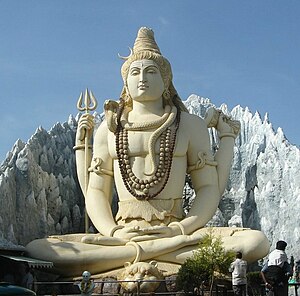User:T12/store/Bhakti yoga
Template:Hinduism small Template:Vaishnavism Template:Advaita Vedanta Bhakti yoga (Devanāgarī: भक्ति योग) is a spiritual path described in Hindu philosophy as efficacious for fostering love of, faith in, and surrender to God.[1] It is a means to realize God,[2] and is the easiest way for the common person because it doesn't involve extensive yogic practices.[1]
The Bhagavad Gita, Bhagavata Purana and Puranas[2] are important scriptures which expound the philosophy of Bhakti.[3] Hindu movements in which bhakti is the main practice are called bhakti movements—the major schools are Vaishnavism, Shaivism, and Shaktism.[4]
Philosophy
- Main article: Bhakti
Bhakti is a Sanskrit term that signifies an attitude of devotion to a personal God that is similar to a number of human-human relationships (difference is that in bhakti relationships is soul-Supersoul, soul-God) such as beloved-lover, friend-friend, parent-child, and master-servant.[3]
The Bhagavata Purana teaches nine primary forms of bhakti, as explained by Prahlada:[5]
(1) śravaṇa ("listening" to the scriptural stories of Kṛṣṇa and his companions), (2) kīrtana ("praising," usually refers to ecstatic group singing), (3) smaraṇa ("remembering" or fixing the mind on Viṣṇu), (4) pāda-sevana (rendering service), (5) arcana (worshiping an image), (6) vandana (paying homage), (7) dāsya (servitude), (8) sākhya (friendship), and (9) ātma-nivedana(complete surrender of the self). (from Bhagavata Purana, 7.5.23-24)
These nine principles of devotional service are described as helping the devotee remain constantly in touch with God. The processes of japa and internal meditation on the aspirant devotees's chosen deity form (ishta deva) are especially popular in most bhakti schools. Bhakti is a yoga path, in that its aim is a form of divine, loving union with the Supreme Lord. The exact form of the Lord, or type of union varies between the different schools, but the essence of each process is very similar.
The Indian spiritual teacher Meher Baba states, "Out of a number of practices which lead to the ultimate goal of humanity – God-Realization – Bhakti Yoga is one of the most important. Almost the whole of humanity is concerned with Bhakti Yoga, which, in simple words, means the art of worship. But it must be understood in all its true aspects, and not merely in a narrow and shallow sense, in which the term is commonly used and interpreted. The profound worship based on the high ideals of philosophy and spirituality, prompted by divine love, doubtless constitutes true Bhakti Yoga.[6]
The Bhagavad Gita
- Main article: Bhagavad Gita
While it has an extensive list of philosophical and religious associations, the Bhagavad Gita is also seen as a cornerstone for Hindu Bhakti theism, especially within Vaishnavism. However, it has been interpreted by many as being a manual not limited just for devotees of Krishna. Whatever be the case, it is adamant, in Krishna's words, that love and innocent pure intention is the most powerful motive force in a devotee's spiritual life. It is a very succinct and comprehensive statement on the mindset of the Bhakta (loving devotee) of Krishna, Svayam bhagavan:
Engage your mind always in thinking of Me, become My devotee, offer obeisances to Me and worship Me. Being completely absorbed in Me, surely you will come to Me. (B-Gita 9.34)[7]
One can understand Me as I am, as the Supreme Personality of Godhead, only by devotional service. And when one is in full consciousness of Me by such devotion, he can enter into the kingdom of God. (B-Gita 18.55) [8]
Branches
- Main article: Bhakti movement

The main schools of bhakti in Hinduism are five vaisnava sampradayas, among them very popular are speculative philosophers (advaita bhakti as taught by Sankaracarya, avatara of Shiva): Shaivas who worship Shiva, and the his family. Those who worship forms of Vishnu, his avataras, and others associated with him are known as Vaishnavas. Of apasampradayas, non-bona-fide schools of 'bhakti' are Shaktas who worship a variety of goddesses.
Notable proponents of Bhakti
- Narada Muni
- The Alvars c. 2nd century to 8th century
- The Nayanars 5th century to 1010 century
- Adi Shankara 788 to 820
- Ramanujacharya 1017 to 1137
- Madhvacharya 1238 to 1317
- Jayadeva 12th century
- Nimbarka 13th century
- Annamacharya 1408 to 1503
- Vallabha Acharya 1479 to 1531
- Chaitanya Mahaprabhu 1486 to 1533
- Bhadrachala Ramadasu (Kancherla Gopanna) c. 1620 to 1680
- Guru Ravidass
- Narsinh Mehta
- Meera
- Swami Ramanand 1738 to 1802
- Swaminarayan 1781 to 1830
- Tyāgarāja died 1847
- Bhaktivinoda Thakur 1838 to 1914
- Ramana Maharshi 1878 to 1950
- Bhaktivedanta Swami Prabhupada 1896 to 1977
- Pramukh Swami Maharaj 1921
- Jagadguru Kripalu Maharaj 1922
See also
References
- ^ a b Miracle of Konark. Asia Press, 1967.
- ^ a b Paliwal, B.B. 2005. Message of the Purans. Diamond Pocket Books.
- ^ a b Cutler, Norman (1987) Songs of Experience Indiana University Press p. 1 ISBN 978-0-253-35334-4
- ^ Rinehart, Robin Contemporary Hinduism: ritual, culture, and practice ABC-CLIO pp. 45, 51 ISBN 978-1-57607-905-8
- ^ Haberman, David L. (2001) Acting as a Way of Salvation Motilal Banarsidass Publ. pp. 133–134 ISBN 978-81-208-1794-4
- ^ Baba, Meher: The Path of Love, Sheriar Press, 2000, pp. 57-58.
- ^ B-Gita 9.34
- ^ B-Gita 18.55